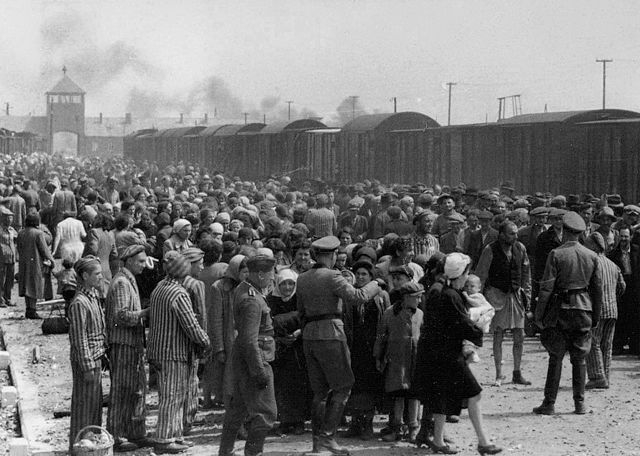Historians of the Holocaust are divided into two schools: the “intentionalists” insist on the central role of Nazi ideology and believe that there was a carefully prepared plan for the extermination of European Jewry; the “functionalists” or “structuralists” by contrast, stress the chaotic nature of the Nazi system, a non-design reflected in their foreign and economic policies as well. According to the latter school, it was this inherent disorder rather than premeditated design that led, through a process of cumulative radicalization, to the systematic extermination of European Jewry.

Wannsee Conference and Einsatzgruppen
On January 20, 1942, Reinhard Heydrich, head of the Reich Security Head Office, convened all secretaries of state of the major German ministries to the Wannsee Conference. This conference is generally held to have been a major turning point, whereby the “final solution of the Jewish question” in Europe by “evacuation” to the East and by other “means” was decided upon. But in fact, the mass extermination of the Jews on an industrial scale, made possible by the creation of death camps, was launched prior to this notorious conference.
Executions by the Einsatzgruppen, mobile killing squads,were abandoned for practical reasons. Although approximately 1.5 million Jews had been shot by the winter of 1941, the Nazis felt that the efficiency of this slow and cumbersome method left much to be desired. Moreover, they found it was bad for the soldiers’ morale. Himmler himself, commander of the SS and as such responsible for the annihilation of the Jews, was persuaded, after having witnessed such an execution, that it badly affected the mental health of those carrying out the execution. The institutionalization of organized murder, founded on a division of labor and carried out in special installations expressly designed for this purpose, distanced the executioner from the victim, an indispensable psychological advantage in an enterprise of annihilation of such a huge scale.
With your help, My Jewish Learning can provide endless opportunities for learning, connection and discovery.
“Euthanasia” and Death Camps
The murder industry began in the Chelmno camp, built in December 1941. Work was carried out in special trucks, where the victims were asphyxiated by exhaust fumes, a method that had been tried before on those whose lives were deemed useless (the “Euthanasia Program”). From September 1939, about 100,000 “Aryan” Germans were assassinated in this manner, in what was named “Operation T4.” Two years later, the personnel responsible for the “euthanasia” program were called upon to apply their expertise to murdering Jews. In the single camp of Chelmno, 150,000 human beings were gassed to death, most of them brought to the camp from annexed territories, the Warthegau district of western Poland and the Lodz Ghetto.
Majdanek, set up in September 1941 as a camp for Soviet prisoners‑of‑war and as a concentration camp for Polish Jews and non‑Jews, became the base for the SS advancing in the East and a reservoir of slave labor for factories in the Lublin region. Extermination installations were built there in the autumn of 1942, but it was only in the winter of the following year that the Zyklon B gas chambers and the crematorium were used for the first time. Of the 200,000 persons killed in Majdanek, about 50,000‑60,000 were Jews.
Belzec, Sobibor, and Treblinka formed part of what the Nazis called “Operation Reinhard,” whose sole purpose was the systematic massacre of Jews. A labor camp existing in Belzec since 1940 was turned into an extermination camp in the autumn of 1941, becoming operative in March 1942. In the same month, the camp at Sobibor was set up to alleviate the overburdened camp of Belzec. The third, Treblinka, received the Jews from Warsaw and the Radom district.
These three extermination factories — with Belzec responsible for about 600,000 victims, Sobibor 200,000, Treblinka 900,000 — shared certain features. Like Auschwitz at a later stage, they were equipped with railroad terminals that the trains entered in reverse. The victims were ordered to undress and then led through a corridor to the gas chambers; the gas was composed of carbon monoxide produced by diesel motors. At first, the corpses were buried in mass graves, later they were burnt in crematoria. The similarity to the “euthanasia” program was evident here too. In August 1941, the camps inspector was SS Sturmbannfiihrer Christian Wirth who, like dozens of other specialists of “Operation T4,” was placed under Odilo Globocnik, the commander of the SS for the region of Lublin.
However, the capital of this bureaucratized and industrialized world of mass murders was Auschwitz. An operative concentration camp since May 1940, in the autumn of 1941 it was equipped with gas chambers. According to the latest estimates, the number of Jews killed in this camp approximated 1.5 million. In Auschwitz II (Birkenau), symbol and synonym of the Holocaust, the Nazi program of mass extermination reached its highest level of “perfection.”
Reprinted with permission from A Historical Atlas of the Jewish People published by Schocken Books.



